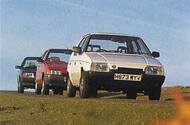Rediscovering the Soviet Superminis: A Look Back at the 1990s Budget Cars
The landscape of Europe was undergoing a seismic shift in the late 1980s and early 1990s. The fall of the Berlin Wall and the subsequent dissolution of the Soviet Union marked the end of an era, not just politically but also in the automotive world. In November 1990, Autocar’s testers took a closer look at three superminis from the Eastern Bloc: the Skoda Favorit 136LX, the Lada Samara 1300SL, and the Yugo Sana 1.4. This examination serves as a fascinating snapshot of a time when these budget cars were vying for attention in a rapidly changing market.
The Context of Change
The backdrop of the 1990s was one of upheaval and transformation. The Autumn of Nations in 1989 ignited a wave of democratic movements across Eastern Europe, leading to the eventual collapse of the Soviet Union in 1991. This political revolution also heralded a shift in consumer expectations, particularly in the automotive sector. As Eastern European countries began to open up to Western influences, the cars they produced were also evolving. The superminis tested by Autocar represented a unique blend of local engineering and foreign collaboration, with Italian and German expertise contributing to their development.
Performance and Specifications: How Did They Stack Up?
When it came to performance, none of these cars were designed to be speed demons. However, they each had their strengths and weaknesses. The Yugo, powered by a Fiat Tipo 1.4-litre engine, boasted the highest top speed of 97 mph and could accelerate to 60 mph in 13.2 seconds. Despite its performance edge, testers noted that the engine felt gruff and noisy, detracting from the overall driving experience.
The Lada Samara, with its 1.3-litre engine, was described as a stable motorway cruiser, though it lacked the power and responsiveness of its competitors. It reached 60 mph in 13.4 seconds and had a top speed of 93 mph. However, the brakes were a significant drawback, with testers reporting a long travel distance and a tendency for premature rear wheel lock-up.
The Skoda Favorit, while the least powerful of the trio with a 1.3-litre engine producing 62 bhp, impressed testers with its eager handling and ride quality. It managed to reach 60 mph in 14.3 seconds and had a top speed of 92 mph. The Favorit was praised for its well-balanced suspension and responsive steering, making it the standout performer in terms of driving dynamics.
Interior Quality and Comfort: A Mixed Bag
As the automotive industry has evolved, so too have consumer expectations regarding interior quality. The superminis from the Eastern Bloc were a far cry from the plush interiors of modern vehicles. Testers noted that only the Yugo offered a soft-touch steering wheel, while the Skoda and Lada featured thin, insubstantial wheels that left much to be desired.
In terms of comfort, the Yugo provided the most spacious interior, accommodating five passengers comfortably. However, the rear seats were criticized for being poorly padded and set too low. The Skoda’s rear bench offered decent knee room but was less spacious than the Yugo’s. The Lada, despite being the longest of the three, failed to utilize its space effectively, with uncomfortable front seats and a high load sill that negated some of the benefits of its hatchback design.
Build Quality: A Reflection of the Times
The overall build quality of these cars was, unsurprisingly, subpar by Western standards. The Yugo suffered from visible distortions in its body panels and a poorly assembled interior that rattled during drives. The Skoda’s exterior was deemed fair, but interior components lacked refinement, while the Lada’s paintwork and finish were criticized for their inconsistency.
Despite these shortcomings, the standard equipment offered in these cars was surprisingly competitive. The Skoda came with alloy wheels, a radio/cassette player, and a well-made toolkit, while the Lada and Yugo offered similar features, albeit with some omissions.
The Verdict: Which Car Came Out on Top?
Ultimately, the Skoda Favorit emerged as the clear winner in this comparison. Testers praised its well-rounded performance, ride quality, and comprehensive equipment list. It was a car that not only met the basic needs of family transportation but also offered a degree of enjoyment behind the wheel. The Lada and Yugo, while they had their merits, fell short in terms of build quality and driving dynamics.
In retrospect, the Favorit represented a turning point for Skoda, a brand that would go on to produce highly regarded vehicles in the following decades. The Lada and Yugo, on the other hand, struggled to adapt to the changing automotive landscape, with the former primarily remaining in Russia and the latter ultimately going bankrupt.
The legacy of these superminis is a reminder of a time when Eastern European cars were both loved and maligned, serving as a bridge between two worlds. As we look back on this era, it becomes clear that these vehicles were not just modes of transport but symbols of a rapidly changing society, reflecting the hopes and challenges of their time.

